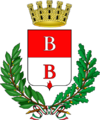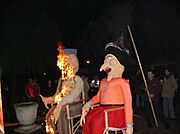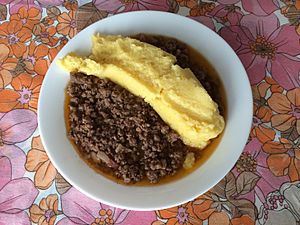Busto Arsizio facts for kids
Quick facts for kids
Busto Arsizio
Büsti Grandi (Lombard)
|
|||
|---|---|---|---|
| Comune di Busto Arsizio | |||
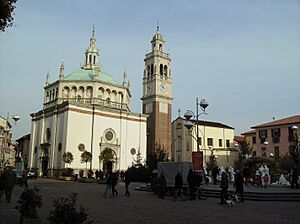
Shrine of Santa Maria di Piazza
|
|||
|
|||
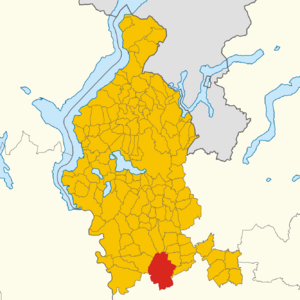
Busto Arsizio within the province of Varese
|
|||
| Country | Italy | ||
| Region | Lombardy | ||
| Province | Varese (VA) | ||
| Frazioni | Borsano, Sacconago | ||
| Area | |||
| • Total | 30.27 km2 (11.69 sq mi) | ||
| Elevation | 226 m (741 ft) | ||
| Population
(December 31, 2017)
|
|||
| • Total | 83,405 | ||
| • Density | 2,755.4/km2 (7,136.4/sq mi) | ||
| Demonym(s) | Bustocchi (for the people born in the city) Bustesi (for the people not born in the city) |
||
| Time zone | UTC+1 (CET) | ||
| • Summer (DST) | UTC+2 (CEST) | ||
| Postal code |
21052
|
||
| Dialing code | 0331 | ||
| Patron saint | Saint John the Baptist and Saint Michael the Archangel | ||
| Saint day | June 24 and September 29 | ||
Busto Arsizio is a city in the Varese province of Lombardy, Italy. It's about 35 kilometers (22 miles) north of Milan. The city is known for its strong industries and businesses. It's the fifth largest city in the Lombardy region by population and the biggest in its province.
History
The first people to live in the Busto Arsizio area were likely the Ligurians. They were known for working with iron and were skilled soldiers. A local historian, Luigi Giavini, believes their influence can still be heard in the local dialect, called Büstócu.
These early people often burned down forests to clear land. This method, called "slash-and-burn," helped them create fields for growing crops like grapes and grains. They also built simple stone huts. When they burned an area, they called it a bustum (which means "burnt" in Latin). To tell different settlements apart, they added another name. For Busto Arsizio, they added arsicium, which also means "burnt" or "arid." So, the city's name basically means "Burnt Burnt"!
Later, around 500 BCE, a Gaulish tribe called the Insubres arrived. They are said to have defeated the Etruscans, who controlled the area at the time.
Busto Arsizio grew along an important route between Milan and Lake Maggiore. This route was an alternative to the main Simplon Pass.
We don't know much about Busto Arsizio's history before the 10th century. That's when its name, loco Busti qui dicitur Arsizio, first appeared in documents. In 1176, people from Busto Arsizio might have fought in the famous Battle of Legnano. This battle, where Frederick Barbarossa was defeated, actually happened near Busto Arsizio, between its area of Borsano and nearby Legnano.
By the 13th century, Busto Arsizio became famous for making textiles (fabrics). Even when different lords ruled the city, it continued to grow. The terrible Bubonic plague hit hard in 1630. But people in Busto Arsizio, who were very religious, prayed to the Virgin Mary, and the plague stopped.
In the mid-1800s, modern factories started to appear. In just a few decades, Busto Arsizio became known as the "Manchester of Italy." This nickname came from Manchester, England, which was a huge textile center. In 1864, King Victor Emmanuel II of Italy gave special rights to the city.
Busto Arsizio kept growing in the next century. In 1927, the nearby towns of Borsano and Sacconago became part of Busto Arsizio. The city was not badly damaged during World War II. This was partly because it hosted an important mission that connected the Allies with local resistance fighters. During the war, Busto Arsizio was a major industrial center for making war supplies. The German forces even moved the Italian national radio there.
The Italian resistance movement in Busto Arsizio mainly used strikes and sabotage. Many resistance members were arrested, tortured, or sent to concentration camps like Mauthausen-Gusen. On April 25, 1945, when the resistance took control, Busto Arsizio had the first free radio channel in northern Italy since the Fascist era.
After the war, many of the big industries in Busto Arsizio declined. They were replaced by smaller family businesses and a new economy based on services. Today, the city is a strong supporter of right-wing political parties like Forza Italia and Lega Nord.
Busto Arsizio's districts
Busto Arsizio has nine main areas, called districts. These are: Sant'Anna, San Michele, San Giovanni, Sant'Edoardo, Madonna Regina, Beata Giuliana, Santi Apostoli, Borsano, and Sacconago.
Demographics
The chart below shows how the population of Busto Arsizio has changed over many years. You can see how the number of people living in the city grew from 1861 to 2010.

Main sights
The most important buildings in Busto Arsizio are its churches. Many of them have been rebuilt over the centuries.
The Shrine of Santa Maria di Piazza
This is the most important building from the Renaissance period (around the 1500s). It's also called the Shrine of the Blessed Virgin of Help. This beautiful building is in the city center and was built between 1515 and 1522.
The Church of Saint John the Baptist
The Church of Saint John the Baptist is in the city center. It was built between 1609 and 1635 by Francesco Maria Ricchini. Its tall bell tower is much older, built between 1400 and 1418. The front of the church, finished in 1701, has many statues. Inside, you can see paintings by Daniele Crespi, a famous artist from Busto Arsizio.
The Church of Saint Michael the Archangel
This is the third largest church in the city. Its bell tower, built in the 10th century, is the oldest building in Busto Arsizio. It was originally part of a Lombard fortress. The current church was designed by Francesco Maria Richini. Inside, there are some important relics, including the body of Saint Felix the Martyr.
The Church of Saint Roch
This church was built after the plague in 1485 and was dedicated to Saint Roch, who people prayed to for protection from the plague. It was rebuilt between 1706 and 1713. Inside, you can find colorful frescos by Salvatore and Francesco Maria Bianchi and Biagio Bellotti.
Museum of Textiles and Industry
The Museum of Textiles and Industry opened in 1997. Its collections show the economic history of Busto Arsizio. You can learn how the city grew from a small farming village into a busy center for manufacturing and trade.
Culture
Traditions and festivals
The city's patron saints are Saint John the Baptist and Saint Michael the Archangel. Their feast days are celebrated on June 24 and September 29.
In winter, a special tradition is the burning of the Giöbia. This is usually a female puppet. Burning it symbolizes getting rid of winter and its problems. In the past, families made their own puppets and spread the ashes in their fields for good luck. Now, it's a more organized public event, but still very important to the people. Busto Arsizio also has two carnival masks, called Tarlisu and Bumbasina, named after types of fabric.
Cuisine
A special dish from Busto Arsizio is bruscitti. It's a braised meat dish made with very thin pieces of beef. It's cooked slowly in wine with fennel seeds.
In 1975, the Magistero dei Bruscitti (Bruscitti Magisterium) was started in Busto Arsizio. This group aims to share knowledge about local traditional cooking. The mayor of Busto Arsizio even made "the day of bruscitti" an official event. It happens every second Thursday in November.
Music
Mina, a famous Italian pop singer, was born in Busto Arsizio. The Italian violinist and conductor Uto Ughi was also born here and still lives in the city.
Sport

Busto Arsizio is home to the Italian Croquet Sport Federation. Their lawns are at the Cascina del Lupo Sporting Centre.
The Pro Patria football (soccer) club plays in Busto Arsizio at the Stadio Carlo Speroni. The team has often reached the Serie B National Championship, which is a high level of football in Italy.
Pro Patria A.R.C. Busto Arsizio is the city's athletics club.
Yamamay Busto Arsizio is the city's main volleyball team. They play in the top national division.
Many important athletes come from Busto Arsizio. Umberto Pelizzari, born in 1965, is considered one of the best freedivers ever. Other notable athletes include former twirling world champion Chiara Stefanazzi and several former football players. The Italian volleyball player Caterina Bosetti was also born in Busto Arsizio.
Transport
Busto Arsizio has two railway stations: Busto Arsizio railway station and Busto Arsizio Nord railway station.
The city's location was chosen partly because it's easy to travel from there. It's right between Varese and Milan, and you can reach either city in about 30 minutes by train.
Economy
Busto Arsizio's economy has changed over time. In the past, farming and manufacturing were the most important parts. But in recent years, the service industry has grown a lot. In 2009, the city's economic output (GDP) was 20% higher than the average in Europe.
Agriculture
The land around Busto Arsizio was never great for farming. So, people living there also did other jobs, like tanning leather. Still, farming was the main activity until the 16th century. Grains were the most important crop. People also raised silkworms for a long time.
Craftsmanship
In the 16th century, Busto Arsizio was known for making moleskin fabric. Working with pewter (a metal) was also common. People made trophies, trays, and plates from it.
Industry
For many years, Busto Arsizio was one of Italy's biggest textile centers. It was famous both in Italy and abroad. The city saw the rise of new business owners who started the first textile factories. This also created a new type of worker: the "worker-peasant," who worked in factories but also continued some farming. The city earned the nickname "the Manchester of Italy" or "the city of 100 chimneys" because of all its factories.
Services
In 1873, Eugenio Cantoni, Pasquale Pozzi, and other business owners from the cotton industry started the Bank of Busto Arsizio. This bank later became a major Italian credit institution during World War I.
International relations
Twin towns — sister cities
Busto Arsizio has special friendships with other cities around the world. These are called twin towns or sister cities:
 Domodossola, Italy
Domodossola, Italy Épinay-sur-Seine, France
Épinay-sur-Seine, France Nacfa, Eritrea
Nacfa, Eritrea Cixi, China
Cixi, China
People
- Mario Caccia (1920), Italian footballer
- Massimiliano Gioni (1973), Italian art curator
Images for kids
See also
 In Spanish: Busto Arsizio para niños
In Spanish: Busto Arsizio para niños



